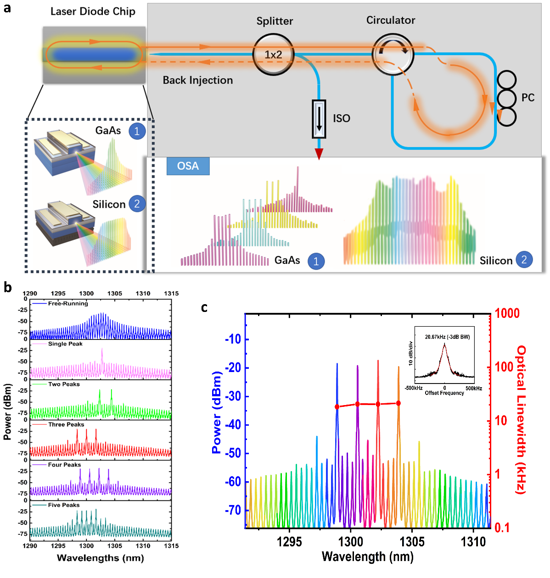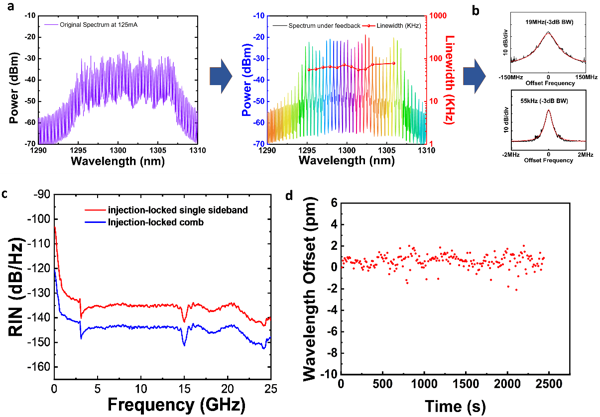Direct epitaxial grown InAs QD lasers on silicon have attracted significant research attentions with rapid progress over the past decade. But up-to-data, most of researches are based on multi-mode fabry-perot (FP) QD lasers on silicon, which can hardly be implemented in high-performance telecommunications, microwave photonics, and optical interconnects. Therefore, combining direct epitaxially grown InAs QD lasers on silicon with external cavity injection locking becomes trending techniques for generation of narrow-linewidth lasers.
However, conventional optical injection locking techniques are based on single frequency lasers, which can only achieve single frequency locking with critical operation conditions. In general, the stability of direct single frequency injection locking can be significantly influenced by environmental changes, such as temperature and vibration.
On the other hand, with the rapid development of semiconductor processing technology and nonlinear photonics, integrated optical frequency combs (OFCs) appear to be a cutting-edge technology for highly coherent optical comb generation. But OFCs generally require external pump lasers with high power, ultra-high stability and fast tuning speed, which can significantly increase the power budget. Therefore, it is essential to develop a compact narrow-linewidth comb laser on silicon with tunability of comb spacing and outstanding frequency stability.
To address the problems and drive the directly epitaxial grown InAs QD FP lasers into practical applications, a joint research group led by Ting Wang, Zi-Hao Wang and Jian-Jun Zhang from Institute of Physics, Chinese Academy of Sciences reported the multi-wavelength self-injection locking of quantum dot (QD) lasers on silicon with ultra-low optical linewidth and great stability.
The multi-wavelength self-injection locked comb lasers are capable of generating narrow-linewidth optical comb at O-band with tunable comb spacing ranging from 25 GHz to 700 GHz, while the minimum optical linewidth of single comb line can reach 18.36 kHz, which is 3 orders of magnitude reduction from its original value. Most importantly, by using lost-cost multi-mode FP lasers on silicon, highly coherent comb generation shall paves the way for future high-efficiency integrated comb lasers. The relevant research results were published in Photonics Research, Volume 10, No. 8, 2022 (Jia-Jian Chen, Wen-Qi Wei, Jia-Le Qin, Bo Yang, Jing-Zhi Huang, Zi-Hao Wang, Ting Wang, Chang-Yuan Yu, and Jian-Jun Zhang, Multi-wavelength injection locked semiconductor comb laser, Photonics Research, 2022, 10(8): 1840).
In this scheme, two different types of InAs QD FP laser diodes epitaxially grown on GaAs and Si substrates are examined for multi-wavelength injection locking. The QD FP lasers on both a standard GaAs substrate (chip 1) and a Si substrate (chip 2) are separately butt-coupled into a lensed fiber followed by a polarization-maintained fiber (PMF)-based Lyot filter and then directly fed back to the laser itself, as shown in Fig. 1(a).
Here, the Lyot filter consists of a PMF with fixed length, PMF circulator, and polarization controller (PC), where it has one half-wave plate sandwiched by two quarter-wave plates, which together provide an arbitrary phase shift from 0 to 2π. By coupling the initial Gaussian shape comb spectrum into a fiber loop, the comb spectrum is re-selected by the Lyot filter with mode spacing of 300 GHz, which is the fourth order of the original 75 GHz comb spacing.
The free spectral range (FSR) of Lyot filter is created by the phase shift between two orthogonal polarization modes of PMFs. The FSR can be successfully tuned by introducing additional phase shift between 0 to 2π, which is achievable via adjusting waveplates of the PC; that is, varying the birefringence of the Lyot filter. The filtered comb spectrum is then back-injected into the laser cavity with wavelength dependent phase tuning. As shown in Fig. 1(c), the initial 75 GHz comb is self-injection locked while converting into a 300 GHz comb. Most importantly, four self-injection locked comb lines now exhibit a flat-top spectrum instead of the previous Gaussian-shaped comb spectrum.

Fig.1 (a) Schematics of two types of lasers (InAs QD laser on GaAs/chirped InAs QD laser on Si) self-injection locked into multiple wavelengths via a PM-fiber-based external cavity. (b) Optical comb spectral evolution of InAs/GaAs QDLGS from free-running condition into multi-peak injection locking states (single peak to five peaks). (c) Optical comb spectrum of self-injection locked InAs/GaAs QDLGS with narrowed optical linewidth. Insets: measured optical linewidth of self-injection lockedcomb lines.
Beside the tunability of comb spacing, the number of comb channels can also be adjusted by varying the birefringence of the external cavity, as shown in Fig. 1(b). By tuning the waveplates of the PC, single peak injection locking towards five peaks injection locking can be achieved continuously.
Furthermore, in order to further extending the comb bandwidth and integration potential, chirped InAs QD laser on Si is introduced here, by carefully tuning the modal phase of back-injected light through the coupling distance or PC, at injection current of 125 mA, the dual modes intend to merge into a broader continuous spectrum. Here, the filtered single comb line of the free-running comb laser is measured with a linewidth of 19 MHz. After multi-wavelength injection locking applied, the linewidth is reduced to 55 kHz. The number of injection locked comb lines is also increased to 30 peaks, as shown in Fig. 4(a). The -10 dB optical bandwidth measured here is approximately 13 nm. Overall, with third-order injection locking, the Si-based laser is self-injection locked at 75 GHz mode spacing from their free-running FSR of 25 GHz.

Fig.2 (a) Left: The optical spectrum of InAs QD laser on Si operated at higher injection current of 125 mA with merged dual modes. Right: The multi-wavelength injection locked comb spectrum with 75 GHz comb spacing. (b) The measured optical linewidth spectra of original laser modes (top) and self-injection locked comb lines (bottom) both at driving current of 125 mA. The optical linewidths are 19 MHz and 53 kHz, respectively. (c) RIN spectra of injection-locked comb source (blue) and injection-locked SSB up to 25 GHz. (d) Wavelength stability measurements over time.
Additionally, the multi-wavelength injection locked comb lines exhibit average relative intensity noise of approximately -135 dB/Hz (Fig. 2c), which is reasonable level for wavelength division multiplexing (WDM) communications. To show the great stability of multi-wavelength injection locking, wavelength drifting measurements over time is performed with only 700 MHz frequency drift over 60 minutes, as shown in Fig. 2d.
Compared to the traditional schemes of single frequency injection locking, multi-wavelength injection locked InAs QD lasers on silicon exhibit superior properties, such as low cost, cob spacing tunability and high locking stability, which has the great potential for many integrated photonic applications.
The article reports the observation of multi-wavelength injection locking simultaneously on InAs QD lasers with external cavity. Moreover, the scheme with narrow optical linewidth and excellent locking stability can be further applied into fields, such as integrated silicon photonics and microwave photonics.


